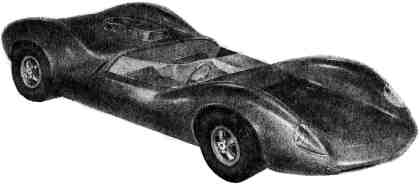LOTUS 3O
THE MOTOR January 22 1964, p. 42.
Even for a Lotus the body is exceptionally low. The top of the windscreen is only 26 in. high, 5 in. lower than the rear wheel covers and 4 in. lower than the front ones so that the view to left and right will be rather obscured. Otherwise it is certainly not, a small car with its overall length of 13 ft. 9 in. and width of 5 ft. 8 in., but much of this is accounted for by overhang of the light glass-fibre body which is moulded in one piece, trapped in place by the front suspension mountings and supported by light cross members at intervals. The whole chassis frame is fed into it through the large engine compartment opening in the tail.
From two very small oval entries in the nose cowling, air flows into a sealed plenum chamber and can only escape through the two small radiators, 8 in. x 15 in., one in front of each wheel arch The spare wheel lies flat in the nose.
At the time of going to press many of the design details remained to be finalized so that even in prototype test form it is likely that there will be departures from this description. Before it makes its first appearance in competition (probably in the spring) further modifications may be necessary. Recent. Le Mans history has shown that the fastest cars, such as the Ferraris, become intensely critical to aerodynamic lift and pitching moments at speeds approaching 200 m.p.h. and the, Lotus will be lighter than any of these. Some of the pre-war German record-breaking cars, of which the Lotus is reminiscent in appearance, were far from stable in side winds. It may prove necessary to add fin area at the back to counterbalance the de-stabilizing yawing moments of the front wheel covers which could act as forward mounted fins.
could produce quite a considerable nose-up pitch angle when accelerating hard even at very high speeds and, of course, a reversal of this angle when braking. With variable rate suspension these changes of trim affect the handling by altering the ratio of front/rear roll stiffness, by changing the wheel camber angles and by modifying high-speed aerodynamic lift effects and although spring rates have not yet been settled it is likely that the Lotus 30 will be considerably harder sprung than most previous models, to minimize these effects. A similar trend may be expected in the very powerful Grand Prix cars of 1966 onwards.
As the drawing shows, the rear suspension design follows current racing Lotus practice with outboard Girling 11-in. disc brakes, cast magnesium alloy hub carriers and 2° of negative camber on each back wheel. The rear roll centre has been kept low (about 2½ in. to 2 in. above ground level) in order to reduce weight transfer on corners but otherwise, although a considerable rearward weight bias may be expected, no particular efforts have been made to build in understeer. Roll understeer has been avoided since geometrical roll-steer effects of any kind are inimical to high-speed stability on the straight.
Many cars with all-enveloping low-drag bodies have had extremely limited steering lock but the Lotus finds room under its wheel covers for 35° of movement. Control is by an Alford and Alder rack and pinion of Triumph pattern; steering geometry is arranged with considerable regard to structural convenience and none to Ackermann — since in racing nearly all the cornering is done on the outer wheel the direction in which the inner one is pointing is of little concern. The castor angle is 5°, the camber 1° negative and the front suspension is of ordinary double transverse wishbone layout with Armstrong coil spring/damper units.
An impression of the finished car which we hope will prove clairvoyant.
SPECIFICATION
ENGINE .. .. .. .. Modified Ford V8
Cylinders .. .. V8 with 5-bearing crankshaft Bore and stroke
101.6 mm. X 72.9 mm. (4 in. X 2.87 in.) Cubic capacity .. .. 4,727 c.c. (289 cu. in.)
Piston area .. .. .. .. .. 100.5 sq. in.
Compression ratio . .. .. .. .. 11:1
Valvegear ,. .. .. .. Push rod o.h.v.
DIVIDED RADIATOR
Carburation
4 Weber 48 IDM twin choke down-draught carburetters, fed by 3 Bendix electric fuel pumps from 31½-gallon tanks
Ignition
12-volt coil, centrifugal timing control Lubrication ..
Full flow filter and 3 to 4 gal. dry sump
Cooling .. Water cooling with pump but no fan or thermostat
Maximum power .. .. 350 b.h.p. at 6,500 r.p.m,
Maximum torque .. .. .. .. 320 lb./ft.
Wheel and tyres
Cast magnesium alloy knock-on wheels with 7 in. front rims and 8½ rear rims; tyres, 6.00×13 front 7 00×13 rear
Steering Alford and Alder rack and pinion
DIMENSIONS
Length overall 13 ft. 9 in.; Wheelbase 7ft. 10½ in.
Width overall 5 ft. 8 in.; Track 4 ft. 5 in. at front and rear
Height
Top of screen .. 26 in.
Rear wheel humps 31 in.;
Ground clearance 4½ ;
Crash bar (if fitted) 36 in.
Turning circle .. 32 ft.
Kerb weight Approx. 15 cwt, (without fuel but with oil, water, tools, spare wheel, etc.)
TRANSMISSION
Clutch .. Laycock 8½ in. twin plate diaphragm type with hydraulic operation
Gearbox .. .. 5-speed type 5D5 20 ZF gearbox with synchromesh on all ratios
Internal gearbox ratios 1.00,1.172,1.43,1.765,and 2.50
Final drive .. Spiral bevel in unit with gearbox.
Limited slip differential.
Alternative ratios, 3.0, 3.22, 3.40, 3.56, 3.78, 4.00
CHASSIS
Brakes .. .. Girling disc with BR calipers
Brake dimensions .. .. Front and rear, 11 in. dia.
Front suspension 2 transverse wishbones with Armstrong coil spring/damper units and anti-roll bar
Rear suspension Double wishbones, Armstrong coil spring/damper units and anti-roll bar
Last Updated on March 31, 2021 by Kirk Keyes
